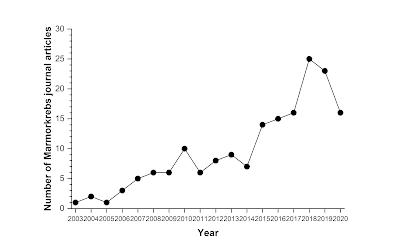As if there weren’t enough reasons to hate 2020, the number of Marmorkrebs papers published was down from the last two years.
It’s impossible to tell if the dip in number of publications is the result of a global pandemic or just the regular up and down you see in these sorts of data.
Marmorkrebs did make international news again this year, mainly because a cloning crayfish invading a cemetery is a great story for Halloween. That was the first record of Marmorkrebs in Belgium, but another first record – on the island of Taiwan – made for fewer news stories but may have been more important in showing how Marmorkrebs are spreading globally.
On the legislative front, Marmorkrebs (and other crayfish) were banned in Japan, the American state of Michigan, and the Canadian province of Saskatchewan. Several jurisdictions like North Carolina and Ontario are considering following suit.
Update, 4 January 2021: Have just found another paper with a 2020 release (Stein and colleagues, 2020), so the count shown in the graph is one too low.
Related posts
2008 was the best year ever for Marmorkrebs research
2009 was tied for the best year ever in Marmorkrebs research
2010 was the best year ever for Marmorkrebs research
2011 was not the best year ever for Marmorkrebs research
2012 was an average year for Marmorkrebs research
2013 was the second best year ever for Marmorkrebs research
2014 was a good year for Marmorkrebs research
2015 was the best year ever for Marmorkrebs research
2016 was the best year ever for Marmorkrebs research
2017 was the second best year ever for Marmorkrebs research







No comments:
Post a Comment